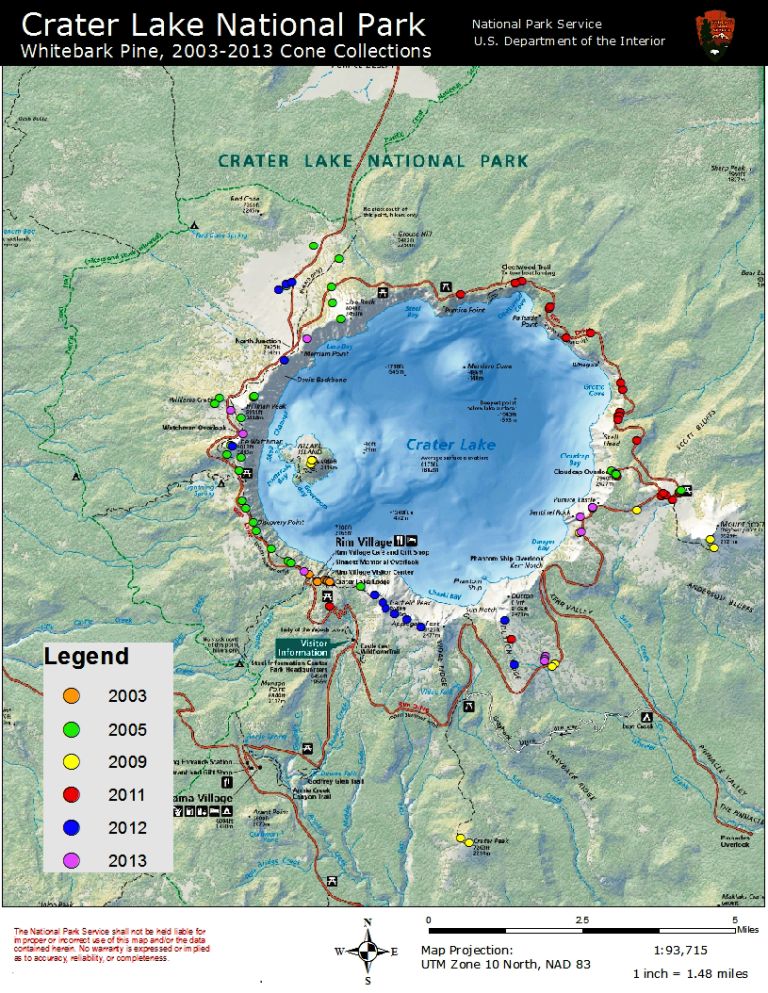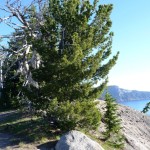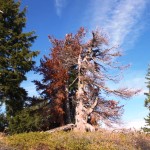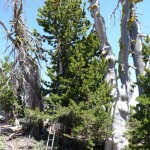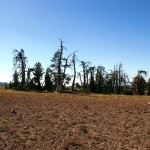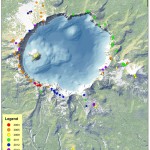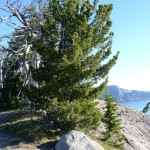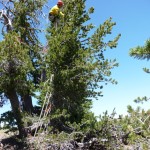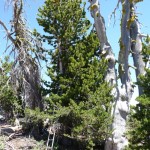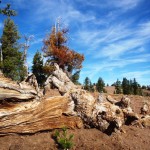2013 WBP Conservation at Crater Lake National Park
Project: Whitebark Pine Conservation at Crater Lake National Park
Agency/Forest or Park/District: Crater Lake National Park, Oregon
Contact: Jen Beck, Crater Lake National Park, P.O. Box 7, Crater Lake, Oregon 97604; (541) 594-3072 jen_beck@nps.gov
Cooperators
Chris Jensen, Deschutes National Forest; Richard Sniezko, USFS Dorena Genetic Resource Center
Source of funding /amount
FHP: $3,250
Supplemental funding: $5,670 from National Park Service, Crater Lake National Park and Deschutes National Forest.
Dates of restoration efforts
Summer 2013
Objectives
Continue identifying rust-resistant whitebark pines within the park and collect seed for rust resistance screening and restoration planting. Monitor ‘Collection trees’ (trees that are currently in or have finished rust resistance trials) for health and rust infection. It is estimated that Crater Lake has lost half of its historic overstory whitebark pines and blister rust infection is 25% in remaining trees. The need is high for identifying rust-resistant trees to maintain genetic diversity and serve as seed sources for restoration plantings.
Acres/ha treated
12 trees
Methods
We propose to collect seed from an additional 15 whitebark pine trees in the park in heavily rust-infected areas. Crater Lake does not have certified tree climbers on staff, so we propose to use the services of Chris Jensen (Deschutes National Forest – DES) and another certified tree climber (from the DES or Oregon State University) to climb 15 phenotypically rust-resistant whitebark pine trees, cage cones, and harvest cones when seeds are ripe. Collection trees will have all documentation completed (e.g., Selected Tree Register) and will enter the Crater Lake Collection Tree Monitoring program – which annually monitors Collection trees by collecting data on health, vigor, insects/disease, etc. Cones will be delivered to the Dorena Genetic Resource Center (DGRC), where seeds will be extracted and seedlings grown for rust-resistance trials and restoration planting.
Planting? If so, source of seedlings? Resistance?
No. Seeds collected are screened for rust resistance.
Outcome
Cones from twelve new Collection Trees were delivered to DGRC in late September 2013 and the seeds have now entered the resistance screening process. Extraction and stratification of seeds are expected to occur shortly.
Twelve new trees with phenotypic resistance to blister rust were identified in additional areas of the park. These trees had their cones caged , collected, and sent to DGRC to enter blister rust resistance trials. Entering the 2013 Collection Trees into resistance trials will add to the growing body of knowledge about the genetic resistance present in Crater Lake’s (and the Cascades’ and range’s) whitebark pines. The 2013 cone collections brought the total number of Crater Lake’s Collection Trees to 101. Seed quantities in excess of those needed for rust resistance testing may be used to grow seedlings for upcoming restoration plantings. Crater Lake initiated a Collection Tree monitoring program in 2012, where “Resistant” whitebark pines (i.e., have received final rust resistance ratings of A-C through trials at DGRC) and “Candidate” whitebark pines (i.e., trees that are currently in trials at DGRC) are monitored each year for health and vigor. This monitoring occurs concurrently with Verbenone application. Results of Collection Tree monitoring in 2013 revealed the following:
• Ten Collection Trees have died since cones were initially collected
• Eight of the ten dead Collection Trees were killed by mountain pine beetle, two Collection Trees died from unknown reasons
• Out of the ten dead Collection Trees, two had an “A” rust-resistance rating, two had “B” ratings, two had “D” ratings, and four were yet-unrated Candidate trees
• The four dead rust-resistant Collection Trees constitute 25% of Crater Lake’s known rust resistant whitebark pines; therefore, mountain pine beetles have killed 25% of our known rust resistant whitebark pines as of 2013.
Monitoring since completion of the project N/A
Dates
Plans for future monitoring?
Will outcome meet goals?
Yes
Future actions/follow up?
We hope to seek funds to continue the resistance screening process (beyond extraction & stratification) for these twelve new trees. We are seeking funds to continue Collection Tree Monitoring and Verbenone application for 2014. Additionally, we will seek funds to collect cones from additional whitebark pines in upcoming years (2014, 2015). We also are starting the planning process for a new restoration planting within Crater Lake NP – hopefully to be conducted in 2015 or 2016.
